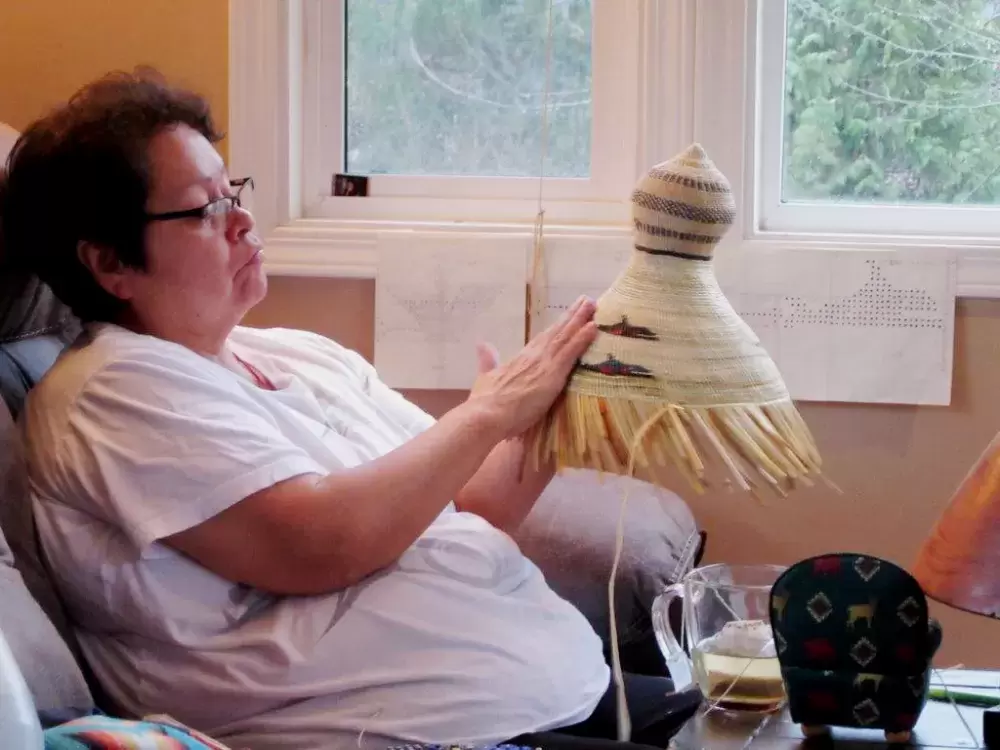Harvesting cedar for basket weaving requires knowledge, skill, physical wellness, and to know when and where to pick, and not to over harvest in one area.
It is not good to venture out on your own and it's not good to strip a cedar tree of all its bark. Stripping the tree completely of its bark will kill the tree.
Mary Martin, Wenuk, a 52-year-old Tla-o-qui-aht member, has become an expert weaver. She was intrigued by a woven bottle that she saw at the Port Place Mall in Nanaimo. She examined the bottle closely, and wondered how it could be done. The work seemed so intricate and delicate.
It took Mary five years to find someone to teach her the basics of weaving.
Julie Joseph of Ditidaht taught Mary how to do twinning, and Ilene Thomas of Ahousat taught her how to make a headband for inside a hat. Mary believes that it was hard to find someone to teach her how to weave due to the banning of the potlatch in the 1900s, and also because of the legacy of Indian residential schools.
There are two types of weaving: basic and fine. Fine weaving is a lifetime process that enables you to learn as you go along. Weaving is very precise. Just like a carver, weavers develop the skills with dedication and practice.
In preparation for weaving, it takes Wenuk two days to split the cedar to ensure the strips are the same thickness and length. You need a smooth rock to flatten the cedar once it is woven into place.
Cedar weaving is meticulous work and requires patience, persistence, time and determination.
Weaving is very therapeutic and healing for Mary. Some days Mary will weave for eight or more hours.
While she is weaving, she has no time to be stressing and worrying about every-day mundane things, because she is so busy concentrating and paying close attention to detail.
Mary's favorite work are Maquinna hats, also known as whaler's or hunter's hats. Wenuk's dream is to teach others how to make whaler's hats. Weaving a whaler's hat is hard, Mary says.
With a hat you weave from the top down and with a basket you weave from the bottom up. A whaler's hat has certain designs that signify the hunting of a whale and strength.
Mary said it was easy for her to do her own whaler's hat designs, because she learned how to do bead work graphs at the age of 11. It takes 30 days to make a whaler's hat, and the most difficult part is doing the top part of the hat.
Mary makes her own designs and knows exactly when and where to add certain colors to give it that dignified look it deserves. People of prestige wore whaler's hats.
Mary said the most exciting project she worked on was teaching 25 people how to weave. She said it was a delight to see them create something new.
Over the years Mary was inspired by the late Alice Paul of Hesquiaht and late Lillian Michael of Nuchatlaht in their fine art of basket weaving.
Mary also makes earrings, bracelets, necklaces and other regalia for potlatches and she travels to different towns and cities to sell her work.
Through her love of weaving Mary has met people from England, Germany, and the United States. She had sold at the Indigenous Games and Tribal Journeys.
Mary has sold some of her weaving to people abroad and most recently she created a hat for Prime Minister Justin Trudeau, which was presented to him by Deb Foxcroft and Ken Watts, the Nuu-chah-nulth Tribal Council’s President and Vice President.







